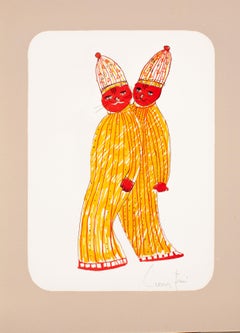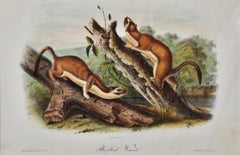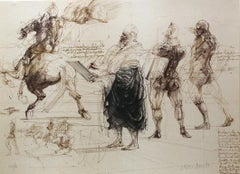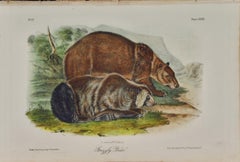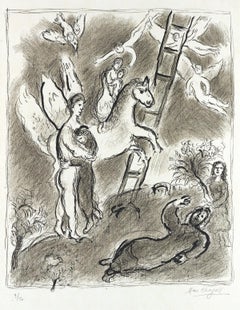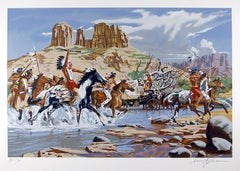Lithograph Animal Prints
to
310
1,133
390
489
176
49
Overall Width
to
Overall Height
to
765
274
159
94
69
64
29
28
21
5
3
2
2
1
94
77
58
54
46
22
788
1,278
149
23
11
15
114
66
82
133
365
179
40
18
1,101
1,082
51
974
703
438
363
335
248
219
207
140
128
124
116
110
102
84
77
69
68
64
57
2,237
1,529
1,251
679
518
286
771
1,178
391
Medium: Lithograph
Red Cat Twins
By Leonor Fini
Located in Columbia, MO
LEONOR FINI
Red Cat Twins
1973
Color lithograph
Ed. 157/230
12.5 x 9 inches
Category
1970s Surrealist Lithograph Animal Prints
Materials
Lithograph
Bridled Weasel: An Original 19th Century Hand-colored Lithograph by Audubon
Located in Alamo, CA
This is an original John James Audubon hand-colored lithograph entitled "Bridled Weasel, No. 12, Plate LX" from John James Audubon's Quadrupeds of North America, published in Philade...
Category
Mid-19th Century Naturalistic Lithograph Animal Prints
Materials
Lithograph
Original Lithograph Horse Anatomy Leonardo Davinci Nude Male Figure Sepia Signed
Located in Milwaukee, WI
"Homage a Leonardo d'Vinci (Leonardo drawing, 3 Figures, Horse from De La Bataille Vol. I)" is an original color lithograph signed by Claude Weisbuch. A group of figures stand to the...
Category
1970s Modern Lithograph Animal Prints
Materials
Paper, Lithograph
"Grizzly Bear", an Original 19th C. Audubon Hand Colored Quadruped Lithograph
Located in Alamo, CA
This is an original John James Audubon hand-colored royal octavo lithograph entitled "Grizzly Bear", No. 27, Plate CXXXI from Audubon's "Quadrupeds of North America". It was drawn on...
Category
Mid-19th Century Naturalistic Lithograph Animal Prints
Materials
Lithograph
Scène Biblique
By Marc Chagall
Located in New York, NY
A very good impression of this lithograph printed in gray and black. Signed and numbered in pencil by Chagall, from an edition of 50.
Category
1970s Expressionist Lithograph Animal Prints
Materials
Lithograph
Trapped, American Realist Lithograph by Harry Schaare
Located in Long Island City, NY
Harry Schaare, American (1922 - 2008) - Trapped, Year: Circa 1980, Medium: Lithograph, signed and numbered in pencil, Edition: 300, Size: 22 in. x 30 in. (55.88 cm x 76.2 cm), De...
Category
1980s American Realist Lithograph Animal Prints
Materials
Lithograph
Leopard
Located in San Francisco, CA
This artwork "leopard" c.1990 is an offset lithograph by noted animals wildlife artist Jacquie Marie Vaux. It is hand signed and numbered 366/750 in...
Category
Late 20th Century American Realist Lithograph Animal Prints
Materials
Lithograph
Earth Day
Located in Naples, Florida
In response to a massive oil spill off the coast of Southern California in 1969, Wisconsin Senator Gaylord Nelson initiated the idea of the first annual Earth Day on April 22, 1970, ...
Category
Late 20th Century Lithograph Animal Prints
Materials
Lithograph
Salle's Hermit Hummingbirds: A 19th C. Gould Hand-colored "Phaethornis Augusti"
Located in Alamo, CA
This is a hand-colored folio sized lithograph entitled "Phaethornis Augusti", Salle's Hermit Hummingbird by John Gould, published in his "A Monograph of the Trochilidae, or Family of Humming-birds", published in London in 1850. The print, which was drawn by Gould and Henry Richter and lithographed by Hullmandel and Walton, depicts three brown, grey, black, white and some green colored hummingbirds about a plant with green leaves and coral and yellow flowers.
This beautiful Gould hand-colored hummingbird lithograph is in excellent condition. The original text page is included.
There are five other unframed Gould hummingbird...
Category
Mid-19th Century Naturalistic Lithograph Animal Prints
Materials
Lithograph
Braque, Oiseaux, Verve: Revue Artistique et Littéraire (after)
Located in Southampton, NY
Lithograph on vélin du Marais paper. Inscription: Unsigned and unnumbered, as issued. Good condition. Notes: From the volume, The Intimate Sketchbooks of G. Braque, Verve: Revue Arti...
Category
1950s Modern Lithograph Animal Prints
Materials
Lithograph
$716 Sale Price
40% Off
"The Jaguar", an Original 19th C. Audubon Hand Colored Quadruped Lithograph
Located in Alamo, CA
This rare original John James Audubon hand-colored royal octavo lithograph is entitled "The Jaguar", No. 21, Plate CI, 101 from Audubon's "Quadrupeds of North America". It was drawn ...
Category
Mid-19th Century Naturalistic Lithograph Animal Prints
Materials
Lithograph
Still Life - Lithograph
Located in Collonge Bellerive, Geneve, CH
(after) Raoul Dufy
Lithograph after a watercolor, published in the book "Lettre à mon peintre Raoul Dufy." Paris, Librairie Académique Perrin, 1965.
Printed signature
Di...
Category
1940s Fauvist Lithograph Animal Prints
Materials
Lithograph
Original Owl and Pussy Cat - Greek theater poster
Located in Spokane, WA
Original The Owl And The Pussycat, by Edward Lear with all text in Greek.
Linen backed and in very good condition. One tiny printing flaw under the foot of the cat.
Translation:...
Category
1960s American Modern Lithograph Animal Prints
Materials
Lithograph
Raoul Dufy (after) - Lithograph
Located in Collonge Bellerive, Geneve, CH
(after) Raoul Dufy
Lithograph after a watercolor, published in the book "Lettre à mon peintre Raoul Dufy." Paris, Librairie Académique Perrin, 1965.
Printed signature
Di...
Category
1940s Fauvist Lithograph Animal Prints
Materials
Lithograph
Georges Braque - Original Lithograph
Located in Collonge Bellerive, Geneve, CH
Georges Braque - Original Lithograph
1963
Dimensions: 32 x 24 cm
Andre Sauret, Monte Carlo
The father of Cubism
Three Cubist that distinguishes art historian periods were initiated and developed by Georges Braque: The Cubist Cézanne (1907-1909), Executive (1909-1912) and synthetic (1912-1922).
Post-Impressionist and fawn, Braque no longer adheres to the contingency of a decorative way or the other. Cézanne’s paintings exhibited at the Grand Palais during the retrospective of 1907 are a revelation: Cézanne sought and invented a pictorial language. In his footsteps, Braque went to the South with the reasons of the Master. He returned with Estaque landscapes and surprising Ciotat it keeps Cezanne geometric model and retains the “passages” continuity from one surface to another to create the sensation of “turning around” of the object represented. But he wants to go after the consequences of the vision of Cezanne. In his paintings Houses in L’Estaque (1908) it simplifies the volumes of houses, neglects detail by removing doors and windows: the plastic rhythm that builds the table. Large Nude , a masterpiece of the period, can be considered the first work of Cézanne cubism .
Systematizing and deepening Braque discoveries open the door analytical cubism. In 1909, his painting became more cerebral than sensual. The pattern is recreated in the two-dimensionality of the canvas, leaving aside any illusionistic perspective. In Still Life with Violin, objects are analyzed facets according to their characteristic elements, each facet referring to a particular view of the object. There are so many facets of points selected view: Table reflects the knowledge of the object and the ubiquity of the eye. Moreover, Braque is looking for the essence of the objects in the world rather than their contingency, which explains the absence of light source and use of muted colors (gray, ocher), contingent aspects of the object . But formal logic has stepped facets, erased any anecdote to the object and ultimately led to his painting a hermetic more marked on the edge of abstraction (see the series of Castle Roche-Guyon ).
Braque, anxious to keep the concrete and refusing at all costs that the logic of Cubism takes the paintings to abstract, reintroduced signs of reality in his paintings in 1912 marks the beginning of Synthetic Cubism. Historians speak of “signs of real” rather than reality because what interests Braque, this is not to put reality into a table, but to create a painting which, by its language, refers to the real. To do this, he invented two major techniques XX th century inclusions and contributions. The inclusions consist of painting objects that have no real depth, materials (wallpaper in Nature morte aux playing cards faux wood is a pictorial inclusion) or letters (calligraphic inclusion in Portuguese ), made first brush and a few months later stencil. Contributions are defined in contrast with the collage on canvas of foreign materials: glued or sand paper, sawdust, etc.. Regarding the collages, Braque used for the first time in September 1912 a piece of adhesive paper imitating faux wood Compote and Glass , then the packet envelope of tobacco Bock in 1912-1913, or an advertisement in Damier , 1913). Inputs and inclusions refer to an external object in the table, without “emulate” this object. Away from their appearances, objects are represented in closest essence of the objects in the real world sense.
This is also the time of Synthetic Cubism that Braque invented paper sculpture. There are, unfortunately, and no one is living proof of a photograph makes it possible to realize: Paper and paperboard.
Métamorphoses period(1961-1963).
In 1961, Georges Braque worked on a Greek head for the Louvre, which obsesses him, and he wishes to free his mind. He tried several times to bring out the paint and the result was unsatisfactory. He thinks the ultimate metamorphosis its Greek head projected in three dimensions. He calls in his studio of Baron Heger Loewenfeld, master lapidary, and he communicates his enthusiasm during the “fateful encounter.” Nine months later, in honor of the eighty years of Georges Braque, Heger Loewenfeld offers the Master of the ring Circe: the famous Greek head finally exorcised, carved in an onyx. Braque Loewenfeld then asked to identify other issues that haunt him.
From dated and signed by Georges Braque, Heger gouaches Loewenfeld shapes works in the fields of jewelery, lapidary art...
Category
1960s Modern Lithograph Animal Prints
Materials
Lithograph
Dogs of the Dalmatian Breed
By James Ward
Located in Boston, MA
Grundy 36, published by R. Acherman. Inscribed in stone lower left: 'James Ward R.A. Pinxt et Delt. / Dogs of the Dalmation breed-from an original picture in the possession of Sir Jo...
Category
1820s Romantic Lithograph Animal Prints
Materials
Lithograph
John Gould - Silvery-throated Tit from 'The Birds of Asia' C. 1850
By John Gould
Located in BRUCE, ACT
Silvery-throated Tit - John Gould lithograph with hand-coloured
size 54 cm X 37 cm
excellent Condition
FREE SHIPPING
Accompanied by the information page from 'The Birds of Asia...
Category
Late 19th Century Lithograph Animal Prints
Materials
Lithograph
$480 Sale Price
25% Off
Untitled
Located in Barcelona, BARCELONA
Includes a Certificate of Authenticity
Category
21st Century and Contemporary Post-Modern Lithograph Animal Prints
Materials
Lithograph
Superb Epimachus Meyeri Bird lithographed by the ornithologists Gould
Located in Milan, IT
This plate is unique because of the bird species' unmistakable beauty and the great scientific and artistic skill with which Elisabeth and Jhon Gould rendered it.
The price quoted h...
Category
Late 19th Century Naturalistic Lithograph Animal Prints
Materials
Lithograph
White-throated Hummingbirds: A 19th C. Hand-colored Lithograph by John Gould
Located in Alamo, CA
This is a remarkable hand-colored folio-sized lithograph entitled "Schistes Albogularis (White-throated Wedge-bill Hummingbirds) by John Gould from his monograph " from A Monograph o...
Category
Mid-19th Century Naturalistic Lithograph Animal Prints
Materials
Lithograph
Israeli Modern Hanukkah Lithograph Silkscreen David Sharir Holiday Serigraph Art
By David Sharir
Located in Surfside, FL
This is a mixed lithograph and serigraph silkscreen as per descriptions i read. this is not signed or numbered and is marked sample. it is a rare artists or printers proof print.
David Sharir was born in 1938 in Tel Aviv, Israel and currently resides there.
David Sharir, the son of Russian immigrants, was born in Israel. Beginning his study of art in Tel Aviv and continuing in Florence and Rome, where he studied architecture and theater design. The brightly colored costumes and intricate stage designs he created for these productions have profoundly influenced his art. When Sharir moved to Jaffa in 1966, his hallmark style was truly developed. Studio, family, and spiritual devotion all serve as inspiration for the imagery in his work. His evolving style combines personal experience, Biblical symbolism, and fantasy.
David Sharir, born 1938, Tel Aviv. Was among the first artists to settle in Old Jaffa in 1966. He depicted biblical subjects with a touch of humour and designed sets and costumes for the theatre and opera.
Graphic Art in Israel Today Tel Aviv Museum, Tel Aviv 1973
Israel 1948-1958: Watercolors, Drawings, Graphics
The Bezalel National Museum, Jerusalem 1958
Jean David, Yosl Bergner, Menachem Shemi, Zvi Mairovich, Ruth Schloss, Nahum Gutman, Moshe Elazar Castel...
Category
20th Century Contemporary Lithograph Animal Prints
Materials
Lithograph
BIG HEAD RED LAVENDER Signed Lithograph, Abstract Animal, CoBrA Artist
By Karel Appel
Located in Union City, NJ
BIG HEAD RED LAVENDER is an original limited edition lithograph by the Dutch artist Karel Appel on printed using traditional hand lithography techniques on archival printmaking paper...
Category
1970s Abstract Lithograph Animal Prints
Materials
Lithograph
$1,224 Sale Price
30% Off
Alexander Calder Circus Reproduction Lithograph After a Drawing
Located in Surfside, FL
(after) Alexander Calder
"Calder's Circus" offset lithograph on wove paper after drawings by the artist
Published by Art in America and Perls gallery in 1964 (from drawings done in t...
Category
1930s American Modern Lithograph Animal Prints
Materials
Lithograph
Grey Fox: An Original 19th Century Hand-colored Lithograph by Audubon
Located in Alamo, CA
This is an original John James Audubon hand-colored lithograph entitled "Grey Fox, No. 5, Plate XXI" from John James Audubon's Quadrupeds of North America, published in Philadelphia ...
Category
Mid-19th Century Naturalistic Lithograph Animal Prints
Materials
Lithograph
Fish and Sky - American Pop Art
Located in London, GB
This work is hand signed in pencil "R. Lichtenstein" at the lower right margin on the mount board. It is also signed, verso.
It is also hand numbered in pencil from the edition of 20...
Category
1960s Pop Art Lithograph Animal Prints
Materials
Lithograph, Screen
John Gould - Ciconia Nigra from 'Birds of Great Britain' C. 1862
By John Gould
Located in BRUCE, ACT
Ciconia Nigra - John Gould lithograph with hand-coloured
size 54 cm X 36 cm
This remarkable ornithology lithograph with hand-finished colour is ...
Category
Early 18th Century Lithograph Animal Prints
Materials
Lithograph
$944 Sale Price
20% Off
Canada Goose: an Original 1st Edition Hand Colored Audubon Bird Lithograph
Located in Alamo, CA
This original first edition hand-colored lithograph entitled "Canada Goose" was produced by J. T. Bowen after a drawing by John James Audubon. It was published in Audubon's first octavo edition of Birds of America in Philadelphia in 1840. It depicts two Canada geese, a male and a female.
This Audubon bird lithograph is in excellent condition other than tiny foci (1-2 mm) of discoloration at the edge of the upper margin of the sheet and some wrinkling along the left edge related to the book binding. The print is otherwise in very good condition. The original descriptive text from Audubon's publication is included with the purchase of this beautiful and striking lithograph. The sheet measures 10.13' x 6.75".
John James Audubon (1785-1851) was a naturalist and artist. He was initially unsuccessful financially prior to the publication of his famous work “The Birds of America”, spending time in debtor’s prison...
Category
Mid-18th Century Naturalistic Lithograph Animal Prints
Materials
Lithograph
Black or Silver Fox: An Original 19th Century Hand-colored Lithograph by Audubon
Located in Alamo, CA
This is an original John James Audubon hand-colored lithograph entitled "American Black or Silver Fox, No. 24, Plate CXVI" from John James Audubon's Quadrupeds of North America, publ...
Category
Mid-19th Century Naturalistic Lithograph Animal Prints
Materials
Lithograph
Original Gene Autry Gold Mine in the Sky US 1-sheet linen backed movie poster
Located in Spokane, WA
Original Gene Autry Gold Mine in the Sky linen-backed original vintage movie poster. The poster does show some foxing on the original theatrical fold marks. Republic Pictures. ...
Category
1940s American Modern Lithograph Animal Prints
Materials
Lithograph
Meerwasser - Aquarium, German antique underwater sea life engraving
Located in Melbourne, Victoria
'Meerwasser - Aquarium'
German tinted wood-engraving, circa 1895.
245mm by 305mm (sheet).
Central vertical fold as issued.
Category
Late 19th Century Naturalistic Lithograph Animal Prints
Materials
Lithograph
Picasso, La Chèvre (The Goat) (Orozco p.82), Histoire naturelle (after)
Located in Southampton, NY
Lithograph on papier bouffant des Papeteries de Casteljoux paper. Unsigned and unnumbered, as issued. Paper Size: 12.99 x 9.84 inches. Catalogue raisonné reference: Orozco, Miguel. T...
Category
1970s Cubist Lithograph Animal Prints
Materials
Lithograph
$716 Sale Price
40% Off
Picasso, Le bélier (The Ram) (Cramer 84; Johnson/Stein 77) (after)
Located in Southampton, NY
Collotype on vélin du Marais paper. Paper size: 14.5 x 11.125 inches. Inscription: Unsigned and unnumbered, as issued. Catalogue raisonné reference: Goeppert, Sebastian, et al. Pablo...
Category
1950s Cubist Lithograph Animal Prints
Materials
Lithograph
$956 Sale Price
20% Off
HUNTING FOR VOLES
Located in Aventura, FL
Lithograph on paper. Hand signed, titled and numbered by the artist. Edition of 350.
Artwork is in excellent condition. Certificate of Authenticity is included. All reasonable o...
Category
Late 20th Century Realist Lithograph Animal Prints
Materials
Paper, Lithograph
$150 Sale Price
50% Off
Picasso, Tête de bélier (Ram’s Head) (Cramer 84; Johnson/Stein 77) (after)
Located in Southampton, NY
Collotype on vélin du Marais paper. Paper size: 14.5 x 11.125 inches. Inscription: Unsigned and unnumbered, as issued. Catalogue raisonné reference: Goeppert, Sebastian, et al. Pablo...
Category
1950s Cubist Lithograph Animal Prints
Materials
Lithograph
$956 Sale Price
20% Off
Antique Dog Lithograph, Taste of Alfred De Dreux, France circa 1870 Wolfhound E
By Alfred de Dreux
Located in SANTA FE, NM
Antique Dog Portrait
Lithograph in the Taste of Alfred De Dreux
Wolfhound E
France, circa 1870
Lithography
25 5/8 x 19 5/8 (28 x 20 frame) inches
Six lithographs of dog portraits....
Category
1870s Romantic Lithograph Animal Prints
Materials
Lithograph
$1,600 Sale Price
20% Off
Original Agricoltori! Tafanoide - Equestrian vintage Italian poster
Located in Spokane, WA
Original Agricoltori Tafanoide Italian vintage poster. Linen-backed and in good condition with edge wear. Colors are still bright and vibrant.
Museum linen backed. This is a good pi...
Category
Mid-20th Century American Realist Lithograph Animal Prints
Materials
Lithograph
$660 Sale Price
20% Off
Picasso, L'aigle (The Eagle) (Cramer 84; Johnson/Stein 77) (after)
Located in Southampton, NY
Collotype on vélin du Marais paper. Paper size: 14.5 x 11.125 inches. Inscription: Unsigned and unnumbered, as issued. Catalogue raisonné reference: Goeppert, Sebastian, et al. Pablo...
Category
1950s Cubist Lithograph Animal Prints
Materials
Lithograph
$956 Sale Price
20% Off
Esperan que l'amour ne tue pas! and L'ALCOOL TUE LENTEMENT prints
Located in Spokane, WA
This is for the set of both (2) original Boris O'Klein prints, part of his series of the 'dirty dogs of Paris." Both are in very good condition,...
Category
Mid-20th Century Art Deco Lithograph Animal Prints
Materials
Lithograph
$760 Sale Price
20% Off
Untitled Signed lithograph on Arches paper by world famous dog artist, unique TP
Located in New York, NY
ROY DE FOREST
Untitled, 1981
Lithograph on Arches paper with four deckled edges.
22 1/2 × 30 inches
Hand signed and annotated Trial Proof, aside from the regular edition of 60
Unfra...
Category
1980s Contemporary Lithograph Animal Prints
Materials
Archival Paper, Pencil, Graphite, Lithograph
The Kangaroos - Lithograph by Paul Gervais - 1854
By Paul Gervais
Located in Roma, IT
The Kangaroos is an original lithograph on ivory-colored paper, realized by Paul Gervais (1816-1879). The artwork is from The Series of "Les Trois Règnes de la Nature", and was publi...
Category
1850s Modern Lithograph Animal Prints
Materials
Lithograph, Paper
"Untitled (Giraffes)" lithograph by Sandra Calder Davidson. Hand signed.
Located in Boca Raton, FL
"Untitled (Giraffes)" lithograph by artist and children's book author Sandra Calder Davidson. Hand numbered 94/100 in front lower left corner. H...
Category
21st Century and Contemporary Contemporary Lithograph Animal Prints
Materials
Lithograph
Horses #II
By Hoi Lebadang
Located in San Francisco, CA
This artwork "titled "Horses #II" 1974 is an original color lithograph, with embossing by French/Vietnamese artist Hoi Lebadang, 1922-2015. It is hand signed and numbered 32/275 in p...
Category
Late 20th Century Modern Lithograph Animal Prints
Materials
Lithograph
Alexander Calder Circus Reproduction Lithograph after a Drawing
Located in Surfside, FL
(after) Alexander Calder
"Calder's Circus" offset lithograph on wove paper reproduction after drawings by the artist
Published by Art in America and Perls gallery in 1964 (from drawi...
Category
1930s American Modern Lithograph Animal Prints
Materials
Lithograph
Mexican Marmot Squirrel: Original 19th Cent. Hand-colored Lithograph by Audubon
Located in Alamo, CA
This is an original John James Audubon hand-colored lithograph entitled "Mexican Marmot Squirrel, No. 22, Plate CIX", from John James Audubon's Quadrupeds of North America, published...
Category
Mid-19th Century Naturalistic Lithograph Animal Prints
Materials
Lithograph
Townsend's Shrew Mole: Original 19th Century Audubon Lithograph
Located in Alamo, CA
This is an original 19th century John James Audubon hand-colored lithograph entitled "Townsend's Shrew Mole", No. 29, Plate CXLV, from Audubon's "Quadrupeds of North America", printe...
Category
Mid-19th Century Naturalistic Lithograph Animal Prints
Materials
Lithograph
Superb Manucodia Comrii Bird lithographed by the ornithologists Gould
Located in Milan, IT
This plate is unique because of the bird species' unmistakable beauty and the great scientific and artistic skill with which Elisabeth and Jhon Gould rendered it.
The price quoted h...
Category
Late 19th Century Naturalistic Lithograph Animal Prints
Materials
Lithograph
Red-breasted Flycatcher Birds: A 19th C. Hand-colored Lithograph by John Gould
Located in Alamo, CA
This is a striking hand-colored folio sized lithograph entitled "Erythrosterna Parva" (Red-breasted Flycatcher) by John Gould from his monograph "The Birds of Great Britain", publish...
Category
Mid-19th Century Naturalistic Lithograph Animal Prints
Materials
Lithograph
Stock, tinted lithograph of cattle and sheep, by Thomas Sydney Cooper
Located in Melbourne, Victoria
Tinted lithograph with white highlights, from 'Thirty-Four Subjects of Cattle', published in 1837 by Thos. McLean, Ackermann and Tilt. Printed at A Ducote's Lithographic Establishmen...
Category
1830s Victorian Lithograph Animal Prints
Materials
Lithograph
Birds of Paradise, German antique natural history chromolithograph print
Located in Melbourne, Victoria
'Paradiesvogel'
(Birds of Paradise)
German chromolithograph, circa 1895.
240mm by 155mm (sheet)
Category
Late 19th Century Naturalistic Lithograph Animal Prints
Materials
Lithograph
"King Duck": An Original First Octavo Edition Audubon Hand-colored Lithograph
Located in Alamo, CA
This is an original John James Audubon hand-colored royal first octavo edition lithograph entitled "King Duck, 1. Male, 2. Female", No. 81, Plate 404, from A...
Category
Mid-19th Century Naturalistic Lithograph Animal Prints
Materials
Lithograph
Original Horse Jumping Steeple Chase 1949 Equestrian vintage poster
Located in Spokane, WA
Original linen backed 1949 International Jumping Steeple Chase Van Gent poster. The events were held at the Royal Cercle Equestre Gent; at the Feestpaleis
The Royal Cercle Eque...
Category
1940s American Realist Lithograph Animal Prints
Materials
Lithograph
Japan Australia's Overseas Airline Qantas original vintage travel poster
By Harry Rogers
Located in Spokane, WA
Original large format Qantas Japan Australia's Overseas Airline vintage travel poster. This antique poster is archival linen backed and in very fine condition. This image was al...
Category
1950s Naturalistic Lithograph Animal Prints
Materials
Lithograph
Original Watch Out .. Safe Direction NRS vintage gun safety poster
Located in Spokane, WA
Original “Watch Out .. Point the Muzzle in a SAFE Direction” vintage National Rifle Association of America vintage poster. Printed in 1946 on a thick cardboard stock. Excellent ...
Category
1940s American Modern Lithograph Animal Prints
Materials
Lithograph
"Bronx Zoo" lithograph and silk screen by Larry Rivers from "New York, New York"
By Larry Rivers
Located in Boca Raton, FL
"Bronx Zoo" lithograph and silk screen by Larry Rivers from "New York, New York" portfolio published by New York Graphic Society. Numbered 5/250, signed Larry Rivers and dated '83 lo...
Category
1980s Contemporary Lithograph Animal Prints
Materials
Lithograph
Cash Cow
Located in Greenwich, CT
Cash Cow a lithograph on paper, 7.5 x 9 inches image size. From the edition of 395 and framed in a contemporary, silver-tone frame. Initialed by the artist lower right, and numbered ...
Category
21st Century and Contemporary Contemporary Lithograph Animal Prints
Materials
Paper, Lithograph
SELVAGGIA Signed Lithograph, Robed Figure, Bird, Surrealism, Latin American
By Norma Bessouet
Located in Union City, NJ
SELVAGGIA is an original hand drawn limited edition lithograph by the Argentine woman artist Norma Bessouet printed using hand lithography techniques on Arches paper, 10% acid free. SELVAGGIA is unframed, in mint condition, full bleed image, hand torn edges, signed in pencil by Ms. Bessouet.
Print size - 28.5 x 20.5 inches, unframed, excellent condition, pencil signed by Norma Bessouet
Edition size - 150, plus proofs
Year printed - 1986
Printer - J K Fine Art Editions Co. NYC
Bessouet, born in Argentina, schooled in Argentina, London and in Italy, where she was able to look to the works of the Old Masters for inspiration. She refers to the artists of the Italian quattrocento along with Velazquez and El Greco as her muses, and traces of these historic artists shine through in her paintings. Her work is in numerous private and public collections throughout the world. Bessouet's art focused primarily around portraits, domesticity and the female nude.
In the original print, SELVAGGIA, Norma Bessouet merges certain Latin American strands of literary magic realism with Surrealism and presents a portrait of an androgynous seated figure, with bald head, serene facial expression, wearing a full length ombre shaded robe, cradling a large, long-beak bird. Ms. Bessouet's sensitive, masterly drawing expresses a fantasy doll...
Category
1980s Surrealist Lithograph Animal Prints
Materials
Lithograph
CROWS BY THE WOODS
Located in Aventura, FL
Lithograph on paper. Hand signed, titled and numbered by the artist. Edition of 350.
Artwork is in excellent condition. Certificate of Authenticity is included. All reasonable o...
Category
Late 20th Century Realist Lithograph Animal Prints
Materials
Paper, Lithograph
$150 Sale Price
50% Off
Le Cirque (The Circus) I
Located in San Francisco, CA
This artwork titled "Le Cirque (The Circus)" is an original colors lithograph by noted French artist Camille Hilaire, 1916-2004. It is hand signed and inscribed J/2 in pencil by the ...
Category
Late 19th Century Impressionist Lithograph Animal Prints
Materials
Lithograph
"#MONKEYPOP", Figurative, Monkey Motif, Depictions of Animals, Lithography
Located in Philadelphia, PA
This piece titled "#MONKEYPOP" is an original print by Jun Lee and is made from stone lithography. This piece measures 30"h x 20"w framed, and is shipped in the pictured black frame....
Category
21st Century and Contemporary Contemporary Lithograph Animal Prints
Materials
Lithograph
"Brave Venture" original lithograph signed pop art dystopian dark abstract birds
Located in Milwaukee, WI
"Brave Venture" is an original color lithograph by Michael Knigin. The artist signed the piece lower right, titled it lower left, and wrote the edition number (142/300) in the lower ...
Category
1970s Pop Art Lithograph Animal Prints
Materials
Lithograph
Lithograph animal prints for sale on 1stDibs.
Find a wide variety of authentic Lithograph animal prints available on 1stDibs. While artists have worked in this medium across a range of time periods, art made with this material during the 21st Century is especially popular. If you’re looking to add animal prints created with this material to introduce a provocative pop of color and texture to an otherwise neutral space in your home, the works available on 1stDibs include elements of orange, blue, purple, yellow and other colors. There are many well-known artists whose body of work includes ceramic sculptures. Popular artists on 1stDibs associated with pieces like this include John James Audubon, Jean Jeacques Grandville, P. Mahler, and Alberto Mastroianni. Frequently made by artists working in the Modern, Contemporary, all of these pieces for sale are unique and many will draw the attention of guests in your home. Not every interior allows for large Lithograph animal prints, so small editions measuring 0.5 inches across are also available
